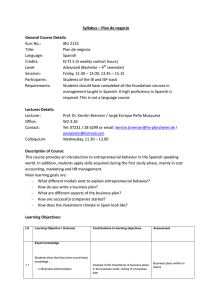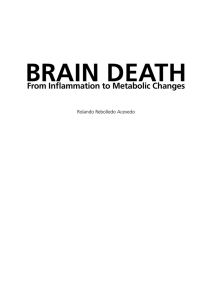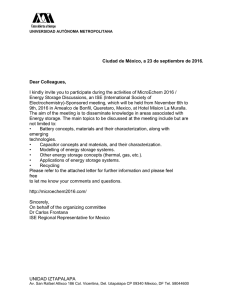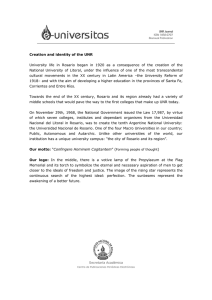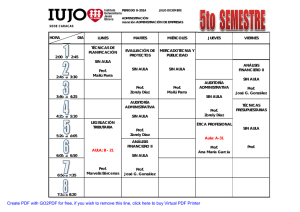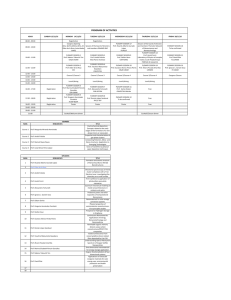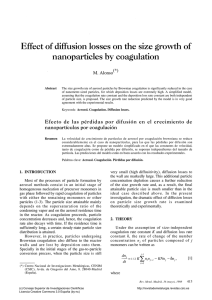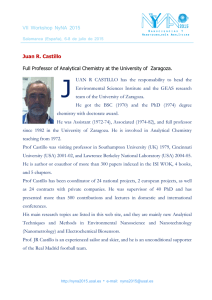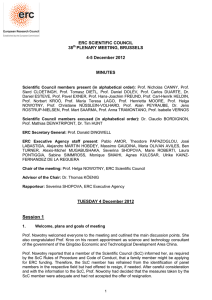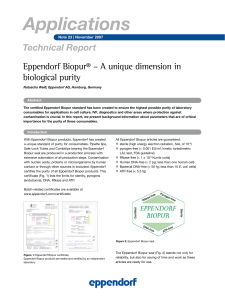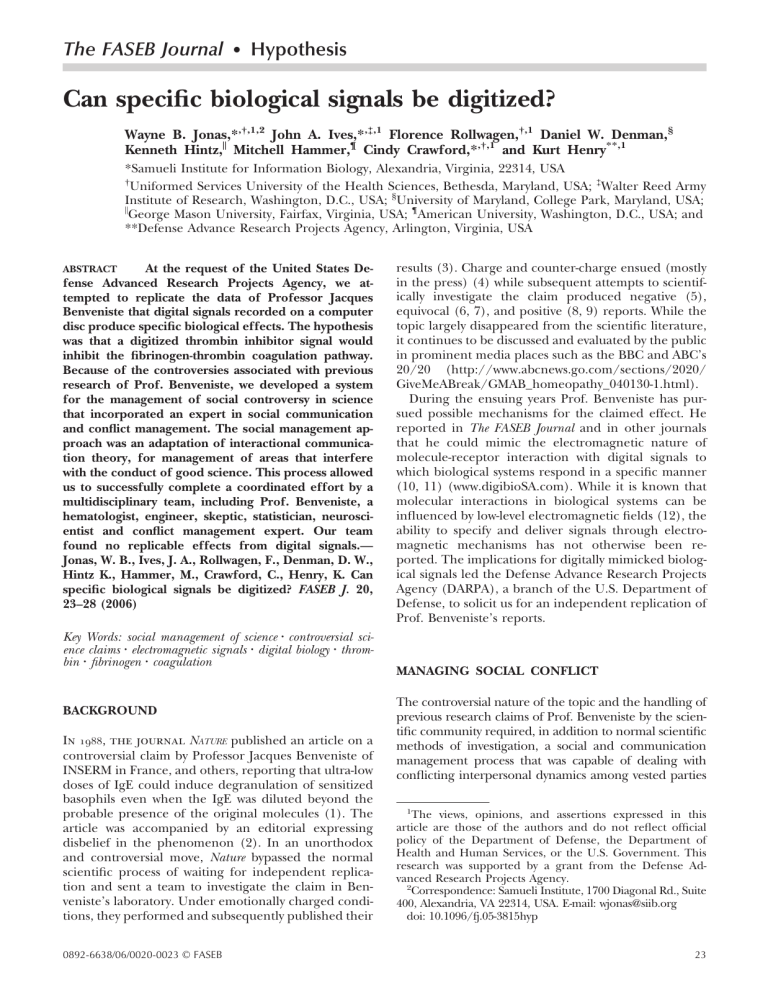
The FASEB Journal • Hypothesis Can specific biological signals be digitized? Wayne B. Jonas,*,†,1,2 John A. Ives,*,‡,1 Florence Rollwagen,†,1 Daniel W. Denman,§ Kenneth Hintz,㥋 Mitchell Hammer,¶ Cindy Crawford,*,†,1 and Kurt Henry**,1 *Samueli Institute for Information Biology, Alexandria, Virginia, 22314, USA † Uniformed Services University of the Health Sciences, Bethesda, Maryland, USA; ‡Walter Reed Army Institute of Research, Washington, D.C., USA; §University of Maryland, College Park, Maryland, USA; 㛳 George Mason University, Fairfax, Virginia, USA; ¶American University, Washington, D.C., USA; and **Defense Advance Research Projects Agency, Arlington, Virginia, USA At the request of the United States Defense Advanced Research Projects Agency, we attempted to replicate the data of Professor Jacques Benveniste that digital signals recorded on a computer disc produce specific biological effects. The hypothesis was that a digitized thrombin inhibitor signal would inhibit the fibrinogen-thrombin coagulation pathway. Because of the controversies associated with previous research of Prof. Benveniste, we developed a system for the management of social controversy in science that incorporated an expert in social communication and conflict management. The social management approach was an adaptation of interactional communication theory, for management of areas that interfere with the conduct of good science. This process allowed us to successfully complete a coordinated effort by a multidisciplinary team, including Prof. Benveniste, a hematologist, engineer, skeptic, statistician, neuroscientist and conflict management expert. Our team found no replicable effects from digital signals.— Jonas, W. B., Ives, J. A., Rollwagen, F., Denman, D. W., Hintz K., Hammer, M., Crawford, C., Henry, K. Can specific biological signals be digitized? FASEB J. 20, 23–28 (2006) ABSTRACT Key Words: social management of science 䡠 controversial science claims 䡠 electromagnetic signals 䡠 digital biology 䡠 thrombin 䡠 fibrinogen 䡠 coagulation BACKGROUND In 1988, the journal NATURE published an article on a controversial claim by Professor Jacques Benveniste of INSERM in France, and others, reporting that ultra-low doses of IgE could induce degranulation of sensitized basophils even when the IgE was diluted beyond the probable presence of the original molecules (1). The article was accompanied by an editorial expressing disbelief in the phenomenon (2). In an unorthodox and controversial move, Nature bypassed the normal scientific process of waiting for independent replication and sent a team to investigate the claim in Benveniste’s laboratory. Under emotionally charged conditions, they performed and subsequently published their 0892-6638/06/0020-0023 © FASEB results (3). Charge and counter-charge ensued (mostly in the press) (4) while subsequent attempts to scientifically investigate the claim produced negative (5), equivocal (6, 7), and positive (8, 9) reports. While the topic largely disappeared from the scientific literature, it continues to be discussed and evaluated by the public in prominent media places such as the BBC and ABC’s 20/20 (http://www.abcnews.go.com/sections/2020/ GiveMeABreak/GMAB_homeopathy_040130-1.html). During the ensuing years Prof. Benveniste has pursued possible mechanisms for the claimed effect. He reported in The FASEB Journal and in other journals that he could mimic the electromagnetic nature of molecule-receptor interaction with digital signals to which biological systems respond in a specific manner (10, 11) (www.digibioSA.com). While it is known that molecular interactions in biological systems can be influenced by low-level electromagnetic fields (12), the ability to specify and deliver signals through electromagnetic mechanisms has not otherwise been reported. The implications for digitally mimicked biological signals led the Defense Advance Research Projects Agency (DARPA), a branch of the U.S. Department of Defense, to solicit us for an independent replication of Prof. Benveniste’s reports. MANAGING SOCIAL CONFLICT The controversial nature of the topic and the handling of previous research claims of Prof. Benveniste by the scientific community required, in addition to normal scientific methods of investigation, a social and communication management process that was capable of dealing with conflicting interpersonal dynamics among vested parties 1 The views, opinions, and assertions expressed in this article are those of the authors and do not reflect official policy of the Department of Defense, the Department of Health and Human Services, or the U.S. Government. This research was supported by a grant from the Defense Advanced Research Projects Agency. 2 Correspondence: Samueli Institute, 1700 Diagonal Rd., Suite 400, Alexandria, VA 22314, USA. E-mail: [email protected] doi: 10.1096/fj.05-3815hyp 23 in the research effort. The approach we used represents a modification of a communication-based process originally developed within the crisis management arena that focuses on the functional meaning of discourse taking place under conditions of disagreement and emotional intensity (13, 14). The process is an adaptation from interactional communication theory and identifies four conflict discourse “frames” that focus communication among parties around interactional “triggers” of conflict escalation and de-escalation (15–17). These four frames and their corresponding behaviors revolve around 1) substantive disagreements around the goals and methods of the research effort; 2) attunement issues (e.g., degree of trust among members of the research team, acceptability of different levels of power and influence, demonstrated consideration for one another); 3) face concerns (e.g., degree to which member of the research team perceive their reputation or professional identity is being attacked or honored); and 4) emotional discord (e.g., degree to which negative emotions arise that increase mistrust and inhibit accomplishment of research objectives). SOCIAL CONFLICT IN MEDICAL RESEARCH We previously developed a process for the adaptation and application of this social and communication management process to controversial scientific research topics. Specifically, under the direction of Dr. Wayne Jonas, then director of the Office of Alternative Medicine (OAM) at the National Institutes of Health (NIH), three major projects were undertaken that provided the substantive basis for development of a social and communication management process for resolving conflicts that can arise in controversial research topics. These projects were 1) a comprehensive case study analysis of the Burzynski antineoplaston clinical trial on adult brain tumors conducted by the National Cancer Institute (NCI) (18, 19); 2) a one-day meeting that focused on the design and implementation of a process for managing conflict dynamics interpretation and judgment processes of OAM sponsored research (20); and 3) a 3-day meeting and follow-up activities that involved 80 cancer researchers and practitioners from the complementary and alternative cancer therapy community and researchers from the NCI. The focus of this effort was on the development of conflict management processes to be integrated into a practice outcomes monitoring and evaluation system (POMES) designed to address research questions related to controversial cancer therapies (21). These findings indicated that difficulties negatively affecting the conduct of research efforts on controversial topics not only reflect differences of opinion on substantive issues (e.g., research protocols, appropriate statistical analysis) but, more important, reflect social conflict among the parties. This leads to interpretive and judgment biases that result in selective filtering and recall of data, dismissal of nonconforming data, increased mistrust of the motives of the other party, reduced ability to 24 Vol. 20 January 2006 empathize with the other, simplified thinking, and overreliance on prior expectations and experiences (18, 19). INSERTION OF SOCIAL MANAGEMENT INTO A RESEARCH PROJECT The most visible aspect of the social management process into this study involved the integration of a communication and conflict resolution professional into the research team. His role was to observe, monitor, and evaluate the social dynamics during implementation of the research project. This involved several functions, including 1) intervention into group decision-making processes around both substantive issues and assessment of attunement, face, and emotional discord dimensions; 2) application of conflict communication skills (e.g., active listening) to key prioritization concerns (e.g., how the research goals are set), development and review of the research approach (e.g., how the research design and protocols are established), execution of the study (e.g., how are protocols actually implemented, how are changes/modifications made to the previously agreed upon research protocols), and interpretation and evaluation of the research findings (e.g., what values and criteria are applied to judge the quality and validity of the research effort); 3) conduct of individual interviews, outside of the normal meetings, with research team members to assess the quality of the group process; 4), discussion of observations of the ongoing social and management process during group meetings; and 5) at the conclusion of the study, preparation of written analysis along with a formal presentation to the research team of the social dynamics that characterized the research effort. This system, while it had never been formally tested in a laboratory setting, seemed appropriate to use during an independent test of Prof. Benventiste’s claims, requested of us by the Department of Defense. THE DIGITAL BIOLOGY EXPERIMENTS The attempted replication project was divided into four phases: protocol development, pre-pilot, pilot, and test phases. In the Protocol Development phase a detailed preliminary protocol was developed and submitted to DARPA for review including a description of the communication and management process to be used. The protocol was reviewed and agreed to by Prof. Benveniste and his staff, including the criterion that he would serve as a consultant and not an author of any final publications that ensued. This was to assure that the replication attempt and subsequent paper were independent. This protocol was further developed after a multidisciplinary consultant team consisting of a biologist, hematologist, statistician, electrical engineer, and communication/conflict expert was recruited. Feedback and modifications of the experimental pro- The FASEB Journal JONAS ET AL. cedures were documented via meetings, memoranda, and email throughout the study. The pre-pilot phase was conducted in our laboratory July 14 –21, 2001 by Didier Guillonnet and Jamal Aissa from Benveniste’s laboratory. They set up an Automated Bio-Analyzer (ABA) machine that delivers the digital signals and automatically runs the experiments (Fig. 1A). A number of modifications to the ABA program and protocol were implemented and verified at that time, including blinding and randomization procedures. These same two individuals, along with Prof. Benveniste, returned on October 30 through November 3, 2001 to run the first pilot phase under the modified protocol. The test phase was then conducted by our research team using the same protocol, but independent of Prof. Benveniste’s team. Between the pre-pilot and pilot experiments, a series of blank runs were made on the ABA with water signals to estimate sample sizes required to observe a 20% effect difference between groups with a P value set at 0.05 for hypothesis determination. According to Prof. Benveniste, a biological system that can be used to detect digital signals is the inhibition of fibrinogen-thrombin coagulation by a digitized thrombin inhibitor (DTI). Our working hypothesis was that there would be no difference in coagulation rates between groups exposed to a digitized thrombin inhibitor (DTI), a digitized water signal (WAT), and no signal (NS), as measured by optical density (OD) curves of samples exposed to these signals. To maximize objectivity and reliability, the DigiBio research team set up an ABA robot that performs the entire protocol, including sample pipetting and delivery of the signal, with minimal human intervention (Fig. 1A, B). The protocol can be summarized as follows. Thrombin dissolved in water (0.3 g/mL) is exposed to the computer recording of either DTI or control solutions consisting of either no electromagnetic (EM) signal or water signal. After exposure, the samples are mixed with fibrinogen (24 mg/mL in 0.1% sodium azide, to prevent bacterial growth) and distributed in 96-well plates. Coagulation was assessed by spectrophotometry and expressed as OD. The entire procedure was automated except for data analysis, stock preparation of fibrinogen and thrombin, and their loading into ABA reservoirs. The basic ABA procedure is as follows. After placement of fibrinogen and thrombin into appropriate reservoirs, the computer program is started. The machine distributes the thrombin into Eppendorf tubes and then places the tube into an EM coil inside of a grounded copper tube open at the top. The computer "informs" the water through the EM coil with the digital signal for 10 min and moves the tube back to the holding rack. It then proceeds in the same way for the other tubes. The recordings (DTI signal, WAT signal, NS) are "played" in a random order determined by an Excel program on start-up of the computer. The “informed” thrombin is then mixed with fibrinogen and 2 aliquots of the thrombin/fibrinogen mixture are distributed side-by-side into the wells of a 96-well microplate where coagulation starts (Fig. 1A). The CAN SPECIFIC BIOLOGICAL SIGNALS BE DIGITIZED? latter is read every 60 s for 1 h using a spectrophotometer and the program saves the data to an Excel spreadsheet. Analysis of this data was done by hand to determine coagulation kinetics. It was agreed at the start of the study that only pilot phase and test phase data would be formally analyzed. However, in the pre-pilot phase, DTI, WAT, and NS samples each produced apparent delayed coagulation (decreased rate of OD increase) 25% of the time, indicating some digital effect might be occurring. Experiments done between the pre-pilot and pilot phases were designed to determine variance and estimate a sample size sufficient to detect a 20% difference between groups. These data were obtained with NS and WAT treated samples only. The ABA machine produced a variance of ⬍ 1% standard error, suggesting that four experiments would be sufficient to detect a 20% difference between samples. No digital effects were seen in 17 experiments with two investigators during this pre-pilot phase. (Fig. 2A) During the pilot phase (October 30 –November 3, 2001) Prof. Benveniste and his team conducted 16 experiments using the three-group design. While these experiments were randomized it was possible to determine when no signal (NS) was the experimental condition by observing a volt/ohm meter placed in parallel with the signal playing from the computer to coil. However, it was not possible to determine when the DTI or WAT signals were being played. Coagulation differences between WAT and NS were ⬍ 1%. However, in 7 of the experiments a 21–28% decrease in mean coagulation rate was observed for DTI (Fig. 2B). A subgroup analysis of pilot phase data showed that all DTI effects occurred when experiments were conducted by one member of Benveniste’s team (Jamal Aissa) and that this usually occurred when using a split sample technique in which he interrupted the operation of the ABA machine to do manual plating followed by the automated plating. Two of the 16 experiments done only by the ABA machine (no interruption) showed effects when Jamal was present. In three instances Jamal set up experiments and then left for the day. None of these showed DTI effects. An example curve of a “successful” experiment is shown in Fig. 2B. After November 3, 2001, the independent test phase was conducted. This consisted of 29 formal experiments run by six different investigators in two different laboratories using the same three group design conducted in the pilot phase. Mean coagulation differences between groups was 1–2% and nonsignificant (ANOVA F⫽0.04, P⫽0.96; Kruskal-Wallis Chi square⫽0.06, P⫽0.97). The mean optical densities at 40 min were 1.08 ⫾ 0.1 (95% CI: 1.05–1.12), 1.08 ⫾ 0.09 (95% CI: 1.05–1.11), and 1.09 ⫾ 0.08 (95% CI: 1.06 –1.12) for DTI, water, and blank, respectively. An example curve is seen in Fig. 2C. After the test phase was completed, we conducted several experiments using varying concentrations of thrombin and fibrinogen with and without digital signals in an attempt to reproduce the curves illustrated in 25 Fig. 2B with known chemicals. No combination of sample splitting or concentration change exactly reproduced the curves of the Benveniste team. However, adding between 100 and 200 L water or between 2 and 4 ng/mL of the thrombin inhibitor Lepirudin per well resulted in a decreased coagulation rate (Fig. 2D). Statistical results similar to the pilot phase experiments can be produced with these techniques, although the coagulation curve is flatter and more linear than those produced in the pilot phase experiments. In addition, the volume differences required to produce such effects are easily distinguished by visual inspection. There was no evidence of volume or concentration irregularities seen during any of the pilot phase experiments. A detailed analysis of the digital signal conducted by our electrical engineer found no differences between DTI and WAT signals. A simple voltmeter (tester in Fig. 1B) was used to measure the average signal strength being applied to the coils. This was used to verify that a signal was in fact being presented to the samples. The same voltage, and thus signal intensity, was observed when each of these signals was presented to the samples. Verification of procedural protocols was provided by our consultants in statistics and hematology. APPLICATION OF THE SOCIAL MANAGEMENT PROCESS Figure 1. A) Photograph of automated biol-analyzer (ABA). Photograph of ABA work surface. Six Eppendorf tubes are placed by hand, starting from far left, in each of the two Metallic (soft iron) Racks. The robot arm (not pictured) using Disposable tips distributes aliquots of thrombin from the Thrombin reservoir into each of the Eppendorf tubes in Metallic Rack 1. After filling each Eppendorf tube with a predetermined volume of thrombin and before filling the next Eppendorf tube in line, the robot removes the filled Eppendorf tube from the Metallic Rack and places it in the Signal Coil. The tube is left there for 10 min during which time one of three signals (randomly determined) is played: DTI, WAT, or NS (see text). At the end of 10 min the tube is returned to the rack, and the disposable tip is ejected into the Garbage Box. A fresh disposable tip is acquired and the next tube in line is filled and placed in the Signal Coil. After 60 min when all tubes have been “treated” in this way, the robot proceeds to distribute aliquots of fibrinogen from the Fibrinogen reservoir into each empty Eppendorf tube in Metallic Rack 2. After filling each Eppendorf tube with a predetermined volume of fibrinogen and before filling the next tube in line, the robot adds, from the parallel tube, a predetermined volume of treated thrombin. It then mixes the two compounds by repeated pipetting and then distributes the resulting mixture into two side-by-side wells of the Microplate. The robot then proceeds to the next tube down the line and repeats the process until all six of the tubes have been processed and aliquots from each are distributed into the appropriate wells of the Microplate. B) Schematic diagram of the apparatus for “informing water.” The device used for “informing” the water consists of a standard computer fitted with a sound card. The “line-out” outlet of the sound card is linked to the “line-in” of a commercially available stereo hi-fi 26 Vol. 20 January 2006 Ongoing evaluation by our communication and conflict management consultant documented the communication and feedback dynamics that operated within the research team. Conclusions were drawn from extensive observations of interactions during both the conduct of the experiment and research team meetings, in-depth interviews with Prof. Benventiste and his associates along with the members of the research team. The following questions were asked and responses were recorded and later reviewed: 1) How do you feel the study is progressing? 2) Are there particular challenges you face in the conduct of the study? 3) How successful/unsuccessful do you feel your (visit, etc.) has amplifier by a stereo connection: a male minijack (3.5 mm) plug on the sound card side and two cinch plugs on the amplifier side. The wires from an electromagnetic coil (4 ohms) and the probes of an AC voltmeter are plugged into the speaker outlet at the back of the amplifier. When the prerecorded ".wav" files of either DTI or water (WAT) are played by the computer, the signal is delivered to the coil at 4V AC for 10 min. The frequency range is that of the sound card and the amplifier ranging from 20 Hz to 20 kHz. Not shown here is the recording process in which the sample to be recorded is placed between one transmitting and two receiving coils. The transmitting coil produces an electromagnetic noise signal that is passed through the sample and received by the receiving coils. These two receiving coils drive a differential amplifier whose output is connected to the "mic" input of the computer sound card and the recording is achieved as is done with normal sound through a microphone with settings at 44.1 kHz, mono, for 3 s. The FASEB Journal JONAS ET AL. Figure 2. Thrombin-fibrinogen coagulation rates optical density curves representing coagulation rates of the thrombin-fibrinogen mixture exposed to various digital signals, thrombin inhibitors and controls. E, 䊐 ⫽ water (sample not exposed to any digital signal); , ƒ ⫽ water signal (sample exposed to signal produced from plain water); F, ■ ⫽ samples exposed to digitized signal produced from thrombin inhibitor (DTI). A) Example run produced by automated biological analyzer (ABA) with no signals running. Variation between samples was ⬍ 1% over 10 runs completed on 5 different days. B) Example run from “successful” experiment conducted by Jamal Aissa. Delayed coagulation was observed in samples exposed to DTI in 11 of 23 samples analyzed, average inhibition 24% (P⬍0.0001). C) Example curve selected from over 40 runs conducted by seven independent investigators on the digital effect. Variation between samples ⬍ 2% throughout replication attempts (P⫽0.96). D) Example coagulation inhibition differences produced by adding 5 concentrations of the thrombin inhibitor Lepirudin (a hirudin derivative) to test samples compared with digitized water and plain water demonstrating ability of ABA to produce a coagulation inhibition effect with a standard chemical thrombin inhibitor. F ⫽ 4 ng/mL; E ⫽ 2 ng/mL; ⫽ 1 ng/mL; ƒ ⫽ 400 pg/mL; ■ ⫽ 200 pg/mL; 䊐 ⫽ zero Lepirudin present. been? 4) How confident are you that a rigorous scientific study can be completed? 5) Have your own personal views and beliefs been challenged? How? What has been your response? and 6) What explanations for the phenomena under examination do you believe to be most plausible? Why? Results from these interviews revealed strong agreement among all interviewed that the study was progressing well and certain challenges were identified and were thoroughly discussed to everyone’s satisfaction. Prof. Benveniste’s group felt their visit and set-up of the experiment was very successful. To question #4, concerns were expressed by Prof. Benveniste’s group concerning the kinds of interpretations one might give to findings of no significance or inconsistent findings. These concerns were directly addressed, again to everyone’s satisfaction, in an explicit statement by the research team regarding these issues in a follow-up memo of October 31, 2001 (not shown). Responses to the remaining two questions indicated lack of conflict or disagreements in these areas. The overall dynamics of the American research team’s interaction with the Digibio members as well as among themselves was respectful of differences of opinion and collaborative in decision-making. A quantitative assessment of the degree of group consensus within the American research team was achieved. A 21-item Consensus Scale was administered following the conclusion of the research effort to the five members of the American research team. Responses were obtained from three members. This measure, which obtained reliability coefficients of 0.89 in previous administrations, assessed the degree of agreement of respondents to five dimensions of group consensus: effectiveness of decisionmaking process, individual agreement with the group decision, group members' relations, individual effectiveCAN SPECIFIC BIOLOGICAL SIGNALS BE DIGITIZED? ness and opportunity to participate. Results indicated a mean scale score of 4.53/5.00 (4.61, 4.33, and 4.71), suggesting a high degree of overall group consensus among research team members (22). Overall ratings among the three respondents on each of the five subscales of the social consensus measure were similarly high. Overall, all three respondents were in high agreement with one another concerning the strong level of social consensus obtained among the members. The social and communication process was characterized as open in providing opportunities for improvement in communication, establishing fair and consistent protocols for the study, and respectful and direct resolution of differences of opinion during the experiment. Thus, there was an avoidance of the perils of “groupthink phenomena” (23, 24). In addition, a set of guiding principles was established that aided the research team in addressing some important changes/concerns expressed by Prof. Benveniste and his associates at different times during the study as well as facilitating agreement on the interpretation and judgment of the obtained findings by the research team. Prof. Benveniste provided comments on these test results and suggestions but no editing or authorship on the final report for DARPA. For example, one guideline stated, "differing interpretations of the meaning and implications of the data are possible and can be reflected in individual research team member reports." This guideline permitted alternative voices to be heard if full agreement on specific issues or findings was not obtained. Overall, a fair and effective communicative process was established and maintained around research conducted on a highly controversial topic. Thus, the social management process allowed for the project to be 27 completed in a fair and collegial manner in a highly controversial area of science. 1. SUMMARY AND CONCLUSIONS 2. We found no effects from digital signals on the inhibition of thrombin/fibrinogen coagulation. We observed apparent inhibition of thrombin/fibrinogen coagulation by a digital signal when one member of the Benveniste team conducted experiments in our laboratory. We did not observe systematic influences such as pipetting differences, contamination, or violations in blinding or randomization that would explain these effects from the Benveniste investigator. However, our observations do not exclude these possibilities. The digital effects found during ABA runs were seen after manual pipetting by the experimenter in 14 of the 16 runs. While concentration changes in fibrinogen produce statistically similar reduced coagulation rates, the curves from such concentration changes do not mimic those seen in the pilot experiments. In addition, volume changes were not found between samples and all protocol data were run blind, thereby decreasing the probability that pipetting differences occurred systematically between groups. Improvements in blinding (by eliminating the NS control group) and prerandomization control (by delivering randomization codes before each run separate from those generated by Excel) would not alter the basic findings that digital effects were not reproduced by our investigators. Prof. Benveniste died on October 3, 2004. Before he passed away, however, he posited unknown interactions with digital signals that produce these effects and states that he observed similar experimenter variability in his laboratory (personal communication). He stated that certain individuals consistently get digital effects and other individuals get no effects or block those effects. While it is possible that other, unknown “experimenter” factors, such as the influence of chemical residues, energetic emanations or intentionality from individual experimenters could be an explanation for these findings, we did not test these hypotheses nor developed a framework that would control for such factors. Without such a framework, continued research on this approach to digital biology would be at worst an endless pursuit without likely conclusion, or at best premature (25). In addition, we feel that this first incorporation of a systematic social management process into research on a controversial issue has proven useful and is a better skeptical approach to such claims than “armchair” criticism. Future research teams exploring claims that lie outside the normal paradigms of science should consider incorporating such procedures into their investigations. We are pleased to acknowledge with appreciation the late Jacques Benveniste, and his colleagues Didier Guillonnet, and Jamal Aissa for their time, open cooperation, patience, flexibility and assistance in setting up, adjusting and conducting the experiments. Thanks to Ronald A. Chez for his review and editing of the paper. 28 Vol. 20 January 2006 3. 4. 5. 6. 7. 8. 9. 10. 11. 12. 13. 14. 15. 16. 17. 18. 19. 20. 21. 22. 23. 24. 25. Davenas, E., Beauvais, J., Oberbaum, M., Robinzon, B., Miadonna, A., Tedeschi, A., Pomeranz, B., Fortner, P., Belon, P., Sainte-Laudy, J., et al. (1988) Human basophil degranulation triggered by very dilute antiserum against IgE. Nature (London) 333, 816 – 818 (1988) When to believe the unbelievable. Nature (London) 333, 787 Maddox, J. (1988) High-dilution" experiments a delusion. Nature (London) 334, 287–289 Coles, P. (1988) Benveniste controversy rages on in the French press. Nature (London) 334, 372 Ovelgonne, J. H., Bol, A. W., Hop, W. C., and van Wijk, R. (1992) Mechanical agitation of very dilute antiserum against IgE has no effect on basophil staining properties. Experientia 48, 504 –508 Hirst, S. J., Hayes, N. A., Burridge, J., Pearce, F. L., and Foreman, J. C. (1993) Human basophil degranulation is not triggered by very dilute antiserum against human IgE. Nature (London) 366, 525–527 (see comments) Schiff, M. (1994) The Memory of Water, Thorsons (division of Harper Collins Publishers), London Belon, P., Cumps, J., Ennis, M., Mannaioni, P., Sainte-Laudy, J., Roberfroid, M., and Wiegant, F. (1999) Inhibition of human basophil degranulation by successive histamine dilutions: Results of a European multi-centre trial. Inflamm. Res. 48, S17–S18 Brown, V., and Ennis, M. (2001) Flow-cytometric analysis of basophil activation: inhibition by histamine at conventional and homeopathic concentrations. Inflamm. Res. 50, S47–S48 Benveniste, J., Aissa, J., and Guillonnet, D. (1999) The molecular signal is not functional in the absence of "informed water." FASEB J. 13, A163 (abstr.) Thomas, Y., Schiff, M., Belkadi, L., Jurgens, P., Kahhak, L., and Benveniste, J. (2000) Activation of human eurtrophils by electronically transmitted phorbol-myristate acetate. Med. Hypotheses 54, 33–39 Walleczek, J. (2000) Self-organized Biological Dynamics & Nonlinear Control, Cambridge University, Cambridge Hammer, M., and Rogan, R. (1997) Negotiation models in crisis situations: The value of a communication based approach. In Dynamic Processes of Crisis Negotiation: Theory, Research and Practice (Rogan, R., Hammer, M., and Van Zandt, C., eds) pp. 9 –23, Praeger, Westport, CT Rogan, R., and Hammer, M. (2002) Crisis/hostage negotiations: a communication-based approach. In Law Enforcement, Communication, and Community (Giles, H., ed) pp. 229 –254, John Benjamins, Amsherdam Cissna, K., and Sieburg, E. (1981) Patterns of interaction confirmation and disconfirmation. In Rigor and Imagination: Essays from the Legacy of Gregory Bateson (Wilder, C., and Weakland, J., eds) pp. 253–282, Praeger, New York Ruesch, J., and Bateson, G. (1951) Communication: The Social Matrix of Psychiatry, WW Norton, New York Watzlawick, P., Beavin, J., and Jackson, D. (1967) Pragmatics of Human Communication, WW Norton, New York Hammer, M. (1996) Burzynski antineoplaston case study: conflict issues and recommendations. In Office of Alternative Medicine, NIH, Bethesda, MD Hammer, M., and Jonas, W. (2004) Managing social conflict in CAM research: the case of antineoplastons. Integr. Cancer Ther. 3, 59 – 65 Hammer, M. (1996) The management of dispute and judgment process in controversial complementary and alternative medicine research. In Office of Alternative Medicine, NIH, Bethesda, MD Hammer, M. (1997) Practice outcomes monitoring and evaluation system (POMES): Report of recommendations concerning the POMES system. In Office of Alternative Medicine, NIH, Bethesda, MD DeStephens, R., and Hirokawa, R. (1988) Small group consensus: stability of group support of the decision task process, and group relationships. Small Group Behavior 19, 227–239 Janis, I. (1982) Groupthink, Houghton Mifflin, Boston Janis, I. (1989) Crucial Decisions: Leadership in Policymaking and Crisis Management, The Free Press, New York Stent, G. S. (1972) Prematurity and uniqueness in scientific discovery. Sci. Am. 227, 84 –93 The FASEB Journal Received for publication March 1, 2005. Accepted for publication September 23, 2005. JONAS ET AL.
